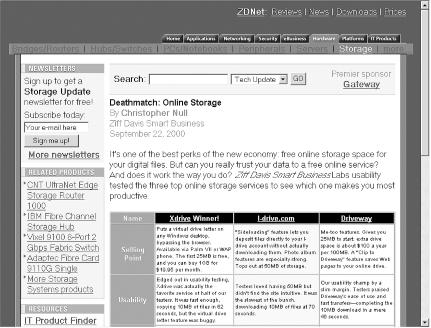Content Modeling
Let’s discuss chunks a bit further. As mentioned earlier, chunks can be big (e.g., collections of reports) or small (e.g., a section heading). Chunks can be nested inside other chunks. Chunks can be defined in any way you like. The problem, of course, is what kinds of chunks to work with—big, small, or somewhere in between? All of these questions might make chunks seem like an annoying and confusing topic. But if you can get your arms around chunks, you can design a very useful piece of bottom-up architecture—a content model—that will benefit both users and content managers alike. As an example, let’s look at the content shown in Figure 12-20.

Figure 12-20. Different audiences might need this content chunked in different ways
Which are the meaningful chunks? Some may be obvious right away, such as the title (“Deathmatch: Online Storage”) and date (“September 22, 2000”). But there may be more to it. For instance, if you are a system administrator, you may need to glean certain types of knowledge when reading this article, such as:
Product names: “Xdrive”; “I-drive.com”; and “Driveway.”
Pricing: “The first 25MB is free, and you can buy 1GB for $19.95 per month”; “Gives you 25MB to start; extra drive space is about $100 a year per 100MB.”
Speed: “...10 MB of files in 62 seconds...”; ...downloading 10MB of files at 70 seconds.”; “...fast transfers—completing the 10MB download ...
Get Information Architecture for the World Wide Web, Second Edition now with the O’Reilly learning platform.
O’Reilly members experience books, live events, courses curated by job role, and more from O’Reilly and nearly 200 top publishers.

